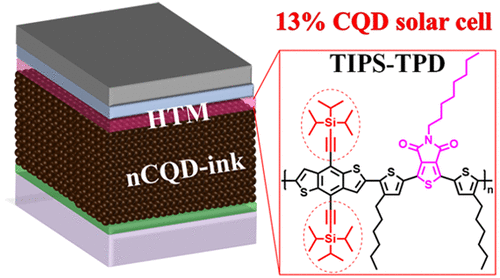当前位置:
X-MOL 学术
›
ACS Energy Lett.
›
论文详情
Our official English website, www.x-mol.net, welcomes your feedback! (Note: you will need to create a separate account there.)
PbS-Based Quantum Dot Solar Cells with Engineered π-Conjugated Polymers Achieve 13% Efficiency
ACS Energy Letters ( IF 22.0 ) Pub Date : 2020-10-15 , DOI: 10.1021/acsenergylett.0c01838 Muhibullah Al Mubarok 1 , Febrian Tri Adhi Wibowo 1 , Havid Aqoma 1 , Narra Vamsi Krishna 1, 2 , Wooseop Lee 3 , Du Yeol Ryu 3 , Shinuk Cho 4 , In Hwan Jung 2 , Sung-Yeon Jang 1
ACS Energy Letters ( IF 22.0 ) Pub Date : 2020-10-15 , DOI: 10.1021/acsenergylett.0c01838 Muhibullah Al Mubarok 1 , Febrian Tri Adhi Wibowo 1 , Havid Aqoma 1 , Narra Vamsi Krishna 1, 2 , Wooseop Lee 3 , Du Yeol Ryu 3 , Shinuk Cho 4 , In Hwan Jung 2 , Sung-Yeon Jang 1
Affiliation

|
While hole extraction is crucial for the external quantum efficiency of conventional n-i-p colloidal quantum dot (CQD) solar cells (CQDSCs), sulfur-passivated p-type CQDs (pCQDs) have been the best hole-transport material (HTM) to date. In this work, we developed organic π-conjugated polymers (π-CPs) that can achieve substantially improved HTM performance compared with conventional pCQDs. A weakly electron-withdrawing triisopropylsilylethynyl (TIPS) group was employed with a weak donor moiety, benzo[1,2-b:4,5:b′]-dithiophene (BDT), in the push–pull structured π-CPs to optimize the optoelectronic properties of the HTM. The CQDSCs using TIPS-containing π-CPs achieved a PCE (13.03%) substantially higher than those previously reported using pCQD (11.33%) or π-CPs (11.25%) owing to the improved charge collection efficiency near the photoactive CQD layer/HTM interface. To the best of our knowledge, our CQDSCs using TIPS-based π-CPs achieved the highest reported PCE among SSE-free CQDSCs.
中文翻译:

具有工程π共轭聚合物的基于PbS的量子点太阳能电池的效率达到13%
尽管空穴提取对于常规的nip胶体量子点(CQD)太阳能电池(CQDSC)的外部量子效率至关重要,但迄今为止,硫钝化的p型CQD(pCQDs)一直是最好的空穴传输材料(HTM)。在这项工作中,我们开发了与常规pCQD相比可以显着提高HTM性能的有机π共轭聚合物(π-CP)。在推挽结构的π-CP中使用弱吸电子的三异丙基甲硅烷基乙炔基(TIPS)和弱给体基团苯并[1,2-b:4,5:b']-二噻吩(BDT) HTM的光电特性。使用含TIPS的π-CP的CQDSC的PCE(13.03%)显着高于先前使用pCQD(11.33%)或π-CP的报告的PCE(11。25%)归因于光敏CQD层/ HTM界面附近电荷收集效率的提高。据我们所知,我们的使用基于TIPS的π-CP的CQDSC在无SSE的CQDSC中实现了最高的PCE。
更新日期:2020-11-13
中文翻译:

具有工程π共轭聚合物的基于PbS的量子点太阳能电池的效率达到13%
尽管空穴提取对于常规的nip胶体量子点(CQD)太阳能电池(CQDSC)的外部量子效率至关重要,但迄今为止,硫钝化的p型CQD(pCQDs)一直是最好的空穴传输材料(HTM)。在这项工作中,我们开发了与常规pCQD相比可以显着提高HTM性能的有机π共轭聚合物(π-CP)。在推挽结构的π-CP中使用弱吸电子的三异丙基甲硅烷基乙炔基(TIPS)和弱给体基团苯并[1,2-b:4,5:b']-二噻吩(BDT) HTM的光电特性。使用含TIPS的π-CP的CQDSC的PCE(13.03%)显着高于先前使用pCQD(11.33%)或π-CP的报告的PCE(11。25%)归因于光敏CQD层/ HTM界面附近电荷收集效率的提高。据我们所知,我们的使用基于TIPS的π-CP的CQDSC在无SSE的CQDSC中实现了最高的PCE。



























 京公网安备 11010802027423号
京公网安备 11010802027423号